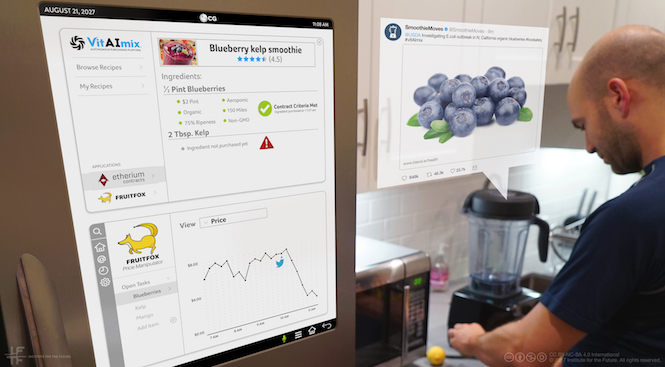Future Now
The IFTF Blog
Artifact from the Future: CLEVER KITCHEN AGENTS
Read coverage of this Artifact in Fast Company »
Read about strategies for building kitchens of the future »

WHAT: It’s the fourth day in a row with no blueberries in your morning smoothie and you’re getting annoyed. Your vitAImix blender downloaded the trending recipe for blueberry kelp smoothies, but your kitchen hasn’t been able to purchase blueberries that match your preferences—below $2 a pint, greater than 75 percent ripeness, non-GMO, organic, and aeroponically farmed within 150 miles. With all the other vitAImixes in town trying to negotiate similar terms, prices are surging. You could give in and pay $7 a pint or bypass your block on GMOs like last time. But then you remember that Twitter bot, FruitFox, you recently downloaded. FruitFox writes articles and tweets about fake food safety scandals to make the price drop for your desired ingredient. An E.coli scandal for Northern California blueberries should do the trick! Your blender sends a tweet that says “@USDA Investigating E.coli outbreak in N. California organic blueberries #foodsafety #VitAImix”—sure to cancel blueberry recipe downloads and remove blueberries from digital shopping carts across the area. Sure enough, within an hour of posting and almost fifty thousand retweets, the price plummets to $1.75 a pint. Your refrigerator places the order, knowing that the food safety scandal doesn’t really exist. By noon you should have a few pints of blueberries at your doorstep.
SO WHAT: The proliferation of the internet of things, in combination with a ubiquitous blockchain platform, will make supply chain data complete and instantaneous. In the food retailers’ constant quest to bulk up their margins via any efficiencies possible, they will leverage machine learning to automatically change their prices based on second-by-second demand, predictive future supply, and even social media trends. As retailers integrate such tactics, new ways for customers to make tradeoffs between price and convenience will pop up: smart refrigerators with their own algorithms to order foods when the price is low, changing the menu when the price is high, and even sabotaging the market in creative ways.
How did we get to this future? Signals from today:
A signal is a small or local innovation that has the potential to grow in scale and geographic distribution. Signals are very specific examples that, when clustered together, point to a larger trend or shift. When creating Artifacts from the Future, IFTF combines today’s early signals to tell a new story about what’s possible in the next decade.
Here are some of today’s signals that, when combined, make Clever Kitchen Agents a possible future:
IBM and Samsung created Autonomous Decentralized Peer-to-Peer Telemetry (ADEPT), a proof-of-concept set of protocols to allow secure, low-cost ways for devices to interact with each other. ADEPT uses Ethereum, a decentralized platform that runs smart contracts.
IBM and a group of global food retailers and companies, including Nestlè, Unilever, Walmart, Kroger, and Driscoll's, formed a coalition to develop blockchain applications across the food system. This will form the backbone for information that appliances will require to purchase foods that adhere to a family's preferences.
Amazon's acquisition of Whole Foods indicates the extent to which devices in the home are already becoming shopping agents connected to a vast logistics and distribution system. Amazon is offering home delivery for grocery purchases through Prime Now, and Whole Foods' private label products are increasingly available to purchase through Amazon's online channels.
As we employ autonomous systems to act on our behalf, algorithms designed to negotiate efficiently may take on deceitful tactics. Researchers from Facebook's Artificial Intelligence Research group found that, when designed to be competitive negotiators, algorithmic agents learned to "deceive without any explicit human design, simply by trying to achieve their goals.”
What other signals of this future do you see already happening today? Or, what else becomes possible when these signals combine? We invite everyone to practice being a food futurist and creatively imagining futures that are radically different from the present. Share your ideas with us at [email protected]!
Learn more
This particular Artifact from the Future—Clever Kitchen Agents—is one of six Artifacts developed in conjunction with our recent Food Innovation report, and might be something you would see over the coming decade as Cloud Intelligence revolutionizes the food system. Read more forecasts and signals about how Cloud Intelligence will be an ingredient for food innovation in the future, and explore three strategies for building kitchens of the future.

This Artifact from the Future is a snapshot of what might emerge if forecasts about the future materialize. It was developed as part of our Food Innovation: Recipes for the Next Decade report which is a book of recipes on how to create systems-level change across the food system. This Artifact from the Future is an at-a-glance tool for exploring the fundamental question: What is possible?
Like all IFTF’s Artifacts from the Future, this image offers insights into future everyday lives and is intended to give you an immersive look at a possible future change.



